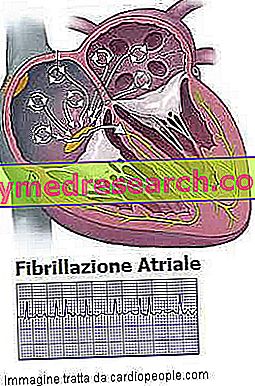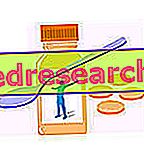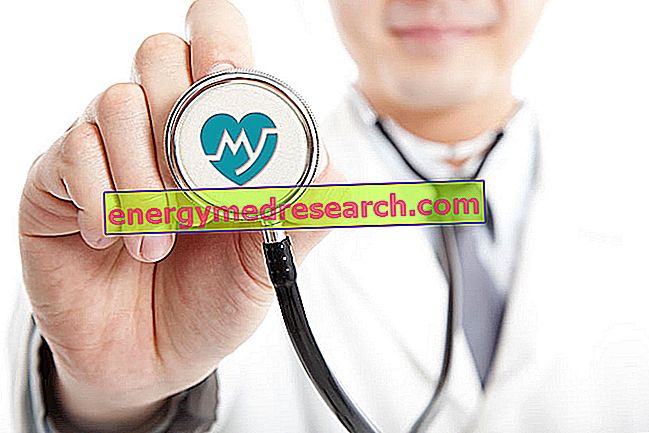Generality
Atrial fibrillation is an alteration of the heart rhythm that makes the heart beat very fast and irregular. It may be a sporadic and very intense phenomenon, or a permanent / chronic phenomenon.

In the presence of atrial fibrillation there is an abnormal conduction of cardiac contraction impulses, such that the walls of the atrial cavities undergo continuous and incessant stresses. All this also negatively affects the activity of the ventricles and the consequent flow of blood pumped by the heart into the bloodstream.
The factors that determine atrial fibrillation are different: cardiopathies are usually among the largest and most frequent responsible; however, we must not forget that arrhythmia can also occur for other causes, such as: hyperthyroidism, hypertension, alcohol and drug abuse, caffeine, etc. The main symptoms of atrial fibrillation arise quickly and consist of: heart disease (or palpitation), vertigo, angina pectoris (chest pain) and dyspnea.
Impaired cardiac activity is assessed by electrocardiogram (ECG), echocardiogram and chest radiograph. The therapy depends on the form of atrial fibrillation and the causes that determine it. Pharmacological interventions (antiarrhythmics, digitalis and beta-blockers) and electrical type (cardioversion and transcatheter ablation) are the appropriate approaches to solve the problem; however, to act on cardiac or other disorders that have given rise to atrial fibrillation, we need a therapy chosen on a case-by-case basis.
Atrial fibrillation is one of the most common forms of arrhythmia; it affects male sex the most and its incidence increases with age. In fact, those over 60 years old are most affected. Estimates of incidence speak of 2.4 cases per 1000 people. In Italy, a 2010 survey reported 700, 000 cases.
NB: to understand some concepts illustrated in the article, it is necessary to know the bases of anatomy and physiology of the heart illustrated in the general article on cardiac arrhythmias.
What is atrial fibrillation
Atrial fibrillation is a profound alteration of heart rhythm originating in the atrium. When it occurs, the heartbeat takes on the following characteristics:
- Variable intensity.
- Irregularities.
- Rapidity and increased frequency of heart contractions.
Therefore, the contractility, that is the capacity of contraction, of the myocardium (the heart muscle) is compromised. The heart, therefore, no longer performs its blood pumping activity properly. In fact, cardiac output becomes irregular, insufficient and no longer satisfies the body's demands.
Given the site in which it occurs, atrial fibrillation is considered a supraventricular ectopic arrhythmia .
In the presence of atrial fibrillation there is an anomalous conduction of contraction impulses, such that the walls of the atrial cavities undergo continuous and incessant stresses. These stresses, in addition to burdening the heart, are completely useless, as the normal cardiac activity does not foresee such close impulses over time. It is in fact important to remember that too many overlapping stimulations, such as those that occur during atrial fibrillation, do not translate into as many contractions, as the myocardium, once contracted, needs time to relax and return again to a new stimulus ( refractory time ). The onset of this situation contributes to making the rhythm of the heart rhythm irregular.
The frequency of the atrial heart rate can reach 350-400 beats per minute, far exceeding the threshold value of normality 100. Furthermore, the numerous contractile impulses do not only affect the atrial cavity, but continue to the ventricle, changing the frequency of heartbeat (ventricular arrhythmia) and consequently altering cardiac output .
The duration and the way in which an episode of atrial fibrillation occurs allow us to distinguish this arrhythmia in three different types:
- Paroxysmal atrial fibrillation . The term "paroxysmal" indicates the sudden appearance of this arrhythmic form. This fibrillation has particular characteristics, which distinguish it from the other two types: it is very high frequency, it is not necessarily linked to other pathologies (cardiac or not) and it is transient, that is it comes and goes. In fact, its duration usually does not exceed 48 hours, although, in some cases, it reaches the week. Paroxysmal fibrillation rarely requires specific therapeutic treatments, as it tends to run out on its own. If the phenomenon tends to repeat itself, even in the absence of other pathologies, antiarrhythmic drugs can be taken, to bring the heart rate back to the normal rhythm.
- Permanent atrial fibrillation . As the term "permanent" says, this form of fibrillation is not resolved quickly. Unlike the paroxysmal form, more than seven days are required, the frequency is slightly lower and a specific therapeutic treatment is needed to stem the arrhythmic phenomenon.
- Chronic atrial fibrillation . By "chronic" we mean the permanent manifestation of arrhythmic episodes, due to a pre-existing pathology. The onset, in fact, of particular pathologies, especially if cardiac, causes atrial fibrillation to become a stable consequence, whose treatment, although specific, is not sufficient to solve the underlying problem. Therefore, the therapy must first of all deal with the pathology that determines the arrhythmia.
The difference in frequency between the paroxysmal and the permanent / chronic forms, affects the ventricle and its contraction differently. In fact, in cases of paroxysmal atrial fibrillation, the ventricular beat reaches a value greater than 140 beats per minute; while, in cases of permanent / chronic atrial fibrillation, the frequency measures 100-140 beats per minute. This diversity is important when discussing the symptoms.
Causes
The causes of atrial fibrillation are numerous. One of the most common determinants is the presence, in the affected subject, of any heart disease for which there is heart failure. In particular, the major culprits of the arrhythmic phenomenon are rheumatic heart disease, due to an infectious disease, and valvular heart disease such as mitral stenosis.
Then:
- rheumatic heart disease
- valvular heart disease (or valvulopathy)
- myocardial infarction
- CHD
- and hypertension
are the cardiac disorders associated with atrial fibrillation. Hypertension is not really a pathology of the heart, but it is the cause of myocardial infarction or coronary heart disease; therefore, it was thought to include it in this list.
Cardiac disorders are not the only diseases that trigger atrial fibrillation. Indeed, other responsible factors have been observed, such as:
- Hyperthyroidism.
- Diabetes mellitus.
- Respiratory diseases.
- Gastroesophageal reflux.
- Hiatal hernia.
- Obesity.
Finally, non-pathological conditions also contribute to the development of atrial fibrillation in a healthy individual. They determine isolated phenomena, with spontaneous exhaustion. For example:
- Excessive smoking.
- Alcohol abuse.
- Excess of caffeine.
- Anxiety.
- Drugs.
- Excess of some drugs.
The simple correction of these conditions helps the subject affected by atrial fibrillation to solve the problem. Therefore, leading a healthy lifestyle once again represents the best prevention. It should also not be forgotten that some of the behaviors just listed are the prelude to pathological disorders far more serious than a "simple" isolated atrial fibrillation.
Symptoms and complications
The main symptoms of atrial fibrillation are:
- Palpitation (or heartbeat).
- Vertigo.
- Syncope.
- Chest pain (angina pectoris).
- Dyspnoea.
- Anxiety.
- Asthenia (weakness).
The symptomatology is closely related to the form of atrial fibrillation manifested by an individual. Some symptoms, in fact, are more evident during the forms characterized by a very high frequency pulse, such as the paroxysmal ones. During these episodes, as anticipated, a high-frequency pulse is established not only in the atrium, but also in the ventricle, resulting in more evident symptomatological manifestations. Despite this, the most dangerous and treated forms are, as we have seen, the permanent / chronic ones, as they are associated with heart disease.
The most serious complication of atrial fibrillation is the possibility of developing a cerebral ischemic stroke . This risk is linked to the negative influence that the arrhythmia has on cardiac output and blood flow. The latter becomes more turbulent. A turbulent flow has a high probability of creating lesions inside the vessels, thus forming thrombi, that is solid and stable masses of platelets (thrombocytes, which serve to repair the lesion). The thrombus acts as an obstacle to the blood flow, occluding the vessels, and can flake off and give rise to emboli, that is, free particles composed of platelet cells. Emboli, traveling through the vessel system, can reach the brain and prevent regular blood supply to certain brain areas. This complication is more likely to occur when atrial fibrillation alternates with atrial fibrillation, or when after a sufficiently prolonged period of fibrillation the sinus rhythm and atrial contractile activity are restored (for this reason cardioversion interventions are preceded and followed by prophylaxis based on oral anticoagulant therapy).
In the presence of atrial fibrillation, moreover, there is a haematic stasis in the atria (which have lost the normal contractile activity); this stasis is greater in the presence of mitral stenosis, due to the atrial dilatation that characterizes this pathology. The stagnation of blood in the atria promotes the development of thrombus in the atrium and it is for this reason that the rheumatic mitral stenosis is associated with a particularly high risk of thrombosis and consequent embolism, as well as a stroke.
Diagnosis
Accurate diagnosis requires a cardiological examination. The traditional tests, valid for the evaluation of any atrial arrhythmia / fibrillation, are:
- Wrist measurement.
- Electrocardiogram (ECG).
- Dynamic electrocardiogram according to Holter.
- Chest x-ray.
- Echocardiography.
Wrist measurement . The cardiologist can draw fundamental information from the evaluation of:
- Arterial pulse . The measurement is performed on the radial artery (at the level of the wrist). It informs about the frequency and regularity of the heart rhythm.
- Jugular venous pulse . It is useful for understanding the level of venous pressure.
Electrocardiogram (ECG) . It is the instrumental examination indicated to evaluate the progress of the electrical activity of the heart. Based on the traces that result, the doctor can estimate the severity and causes of atrial fibrillation.
Dynamic electrocardiogram according to Holter . This is a normal ECG, with the very advantageous difference that monitoring lasts for 24-48 hours, without preventing the patient from performing normal daily activities. It is useful when episodes of atrial fibrillation are sporadic and unpredictable.
Furthermore, since at the origin of atrial fibrillation there can be cardiac and non-cardiac pathologies, it is worth remembering that there are other tests useful to identify the arrhythmic disorder and to understand its causes. They include:
- Chest x-ray.
- Echocardiography.
Chest x-ray . It is a clinical investigation that aims to understand if there are particular pulmonary and respiratory diseases .
Echocardiography . Taking advantage of the ultrasound emission, this non-invasive investigation shows the fundamental elements of the heart: atria, ventricles and valves. The evaluation of the heart allows to verify the presence of a valvular disease or some other cardiac malformation.
Therapy
The therapy to be taken depends on the type of atrial fibrillation. If this is paroxysmal, the treatment consists of:
- Medication administration:
- Digital . Heart rate slows down
- Antiarrhythmics : quinidine derivatives, dofetilide, ibutilide, flecainide, propafenone and amiodarone. They are used to normalize the heart rhythm.
- Electrical treatment:
- Cardioversion . Non-invasive technique, which infuses an electric shock, called shock, in order to reset the altered heart rhythm and restore the normal heartbeat, marked by the atrial sinus node.
Maintenance treatments, always based on digitalis and antiarrhythmics, are also indicated to prevent other paroxysmal episodes, especially if you are certain that the patient suffers from hyperthyroidism or hypertension.
It is, however, important to point out that some circumstances, such as:
- Tolerable symptoms.
- Spontaneous resolution, in the past, of other episodes of atrial fibrillation.
- Absence of cardiac and non-cardiac pathologies.
they make the therapy unnecessary. This is to avoid any side effects related to taking medications, such as quinidine gastrointestinal disorders.
If the fibrillation is of the permanent / chronic type, it must not be forgotten that, at the origin of the disorder, there is a cardiopathy or a pathology of other nature. Solving this basic condition, with a therapeutic approach chosen on a case-by-case basis, is the fundamental step to help restore the normal heart rhythm. Therapy aimed at treating atrial fibrillation will therefore provide support and maintenance. It is the following:
- Medication administration:
- Digital .
- antiarrhythmics
- Anticoagulants . Permanent forms can create thrombo-embolic conditions. These drugs are used in the presence of particular cardiopathies, the mitral valvulopathies, which could generate thrombi or emboli.
- Beta blockers and calcium channel blockers . Slow down the heart rate, acting on the ventricular contractions. They are administered to patients who are tolerant to digitalis.
- Electrical treatment:
- Cardioversion . It is not indicated when the patient is suffering from a heart disease that alters the structure of the heart, such as valvulopathies.
- Trans-catheter radiofrequency ablation . A catheter is used which, once conducted to the heart, is able to infuse a radiofrequency discharge affecting the area of myocardium that generates atrial fibrillation. The affected area is destroyed and this should rearrange the number of contraction pulses by the atrial sinus node. It is an invasive technique.



